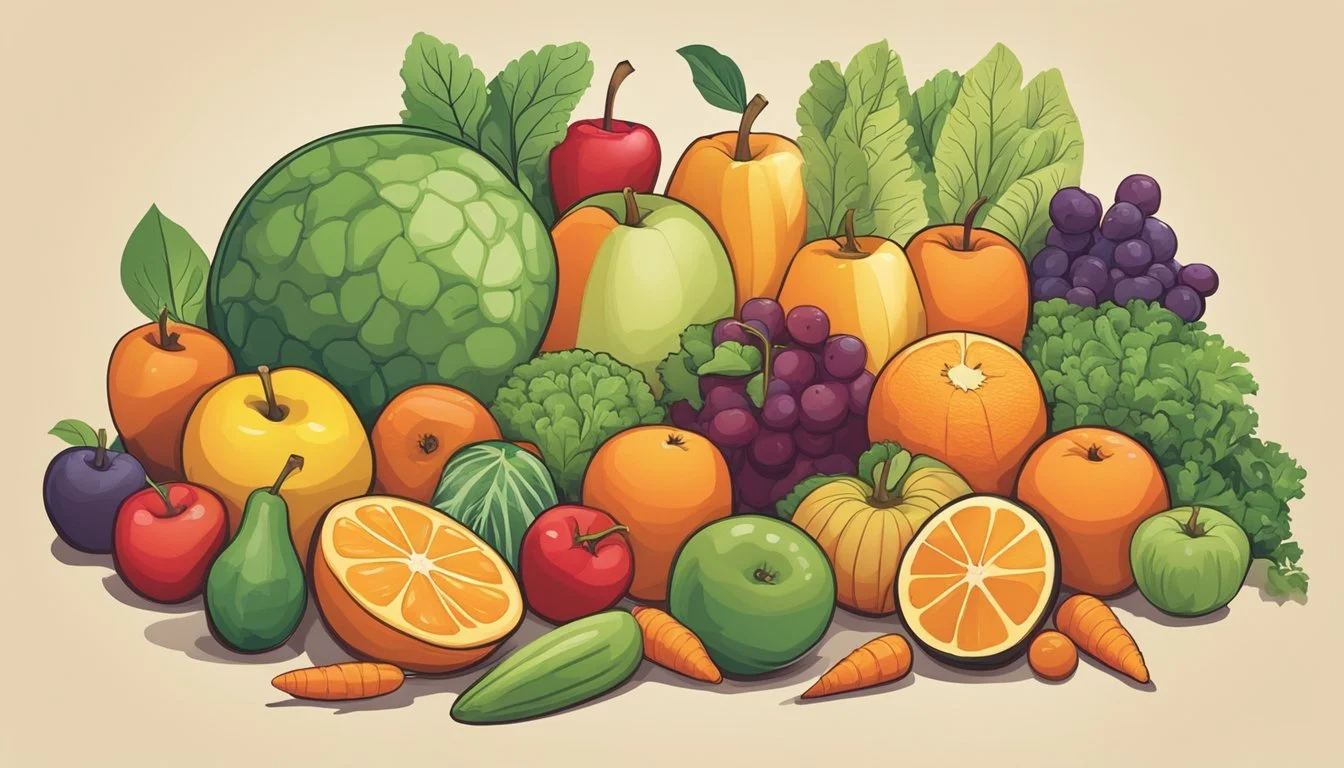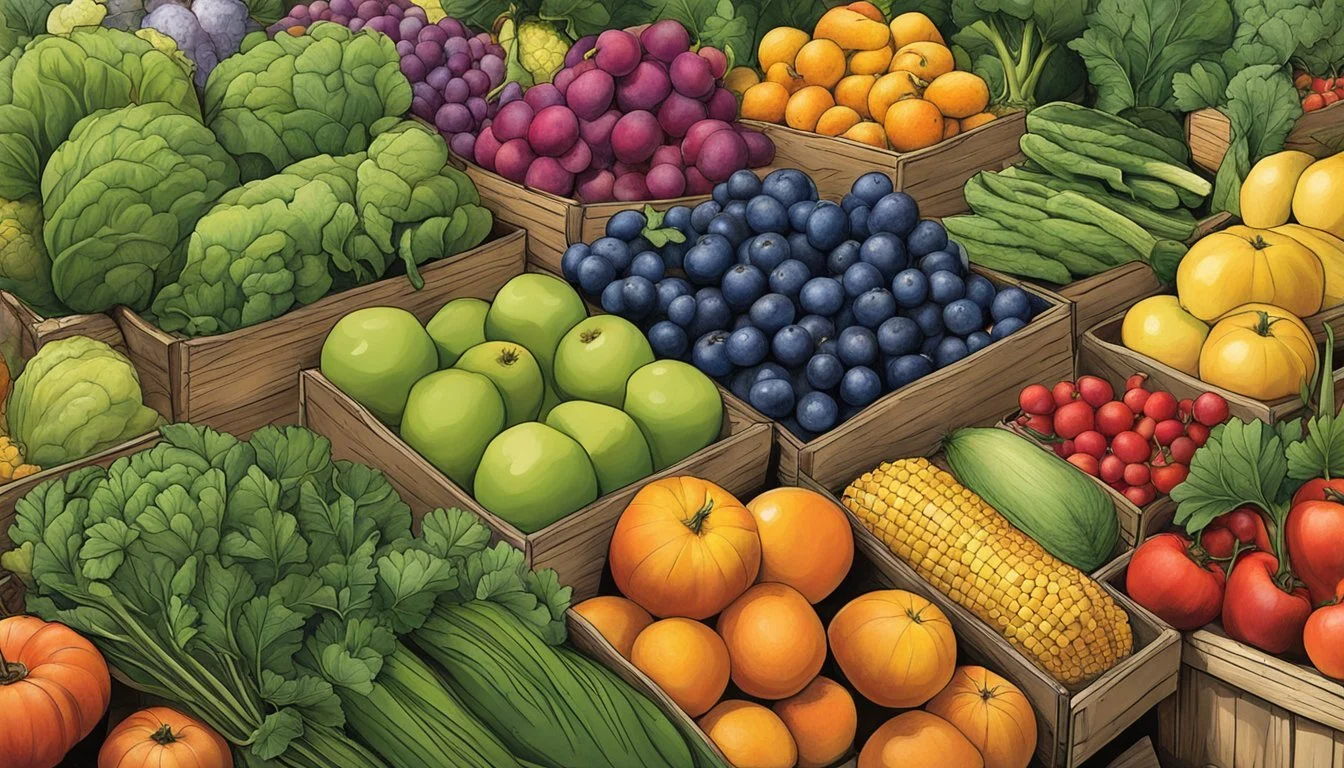Arkansas Seasonal Fruit & Vegetables in January
A Guide to Fresh Produce
This Article is Part of our Arkansas Seasonal Fruit & Veg Calendar
Navigating the produce selection during January in Arkansas calls for a clear understanding of what is seasonally available. The winter month often sees a reduction in the variety of fruits and vegetables due to colder temperatures. However, shoppers can still find an assortment of fresh, quality produce that is harvested during this time.
January's offerings in Arkansas are robust when it comes to hearty greens and certain root vegetables. Farm markets and stores usually have an abundance of kale, (What wine goes well with kale?) spinach (What wine goes well with spinach?), and collards, which thrive in cooler weather. These leafy greens are rich in nutrients and offer versatility in the kitchen, making them a favorable choice for health-conscious consumers.
While the range of fruits is limited during this period, Arkansas residents can enjoy the tangy sweetness of citrus fruits, which are at their peak elsewhere and shipped to local markets. Citrus such as oranges and lemons, often associated with immune-boosting properties, complement the earthy flavors of the seasonal vegetables available. This harmony between available fruits and vegetables provides ample opportunity for fresh, seasonal eating even in the heart of winter.
The Importance of Seasonal Eating
Seasonal eating involves selecting fruits and vegetables that are naturally harvested during specific times of the year. This practice can enhance health, reduce environmental impact, and bolster the local economy.
Health Benefits
Eating seasonally in Arkansas means that consumers can enjoy food at its nutritional peak. For instance, winter produce such as kale and spinach can provide higher levels of vitamin C, which is essential for immune system function. Seasonal food tends to be fresher and thus richer in nutrients compared to produce that is shipped across long distances.
Vitamin C in seasonal produce: Helps fight common winter ailments.
Environmental Impact
Seasonal eating supports the environment by reducing the carbon footprint associated with transportation of food across great distances. When consumers choose local and in-season fruits and vegetables, they decrease the demand for out-of-season imports.
Reduced transportation needs: Leads to lower greenhouse gas emissions.
Economic Advantages
Purchasing seasonal produce directly supports the local economy. Money spent on local farmers' markets circulates within the community, creating jobs and supporting regional agriculture.
Support for local farmers: Builds a stronger local economy.
Lower production costs: Can result in savings passed onto consumers.
Arkansas's Climate and Agriculture
Arkansas's diverse climate significantly influences its agricultural output, particularly in the winter months. This environment requires specific growing practices to ensure fruitful harvests.
Winter Weather Conditions
In Arkansas, winter weather can be varied, spanning mild to harsh cold conditions from December through February. Temperatures range from an average high in the low 50s to an average low in the upper 20s (degrees Fahrenheit). Precipitation during this season typically includes rain and occasional snowfall, potentially impacting late winter crop yields.
Average high: Low 50s°F
Average low: Upper 20s°F
Precipitation: Rain and occasional snow
Weather patterns profoundly affect the type of crops that can be cultivated during these months, as some plants are more resistant to frost and cold conditions than others.
Soil and Growing Practices
Soil quality in Arkansas varies across regions but generally contains a mix of loam, silt, and clay, offering a fertile foundation for a variety of crops. During the winter, growers might employ cover crops or mulching to protect the soil from erosion and nutrient depletion.
Soil Composition:
Loam
Silt
Clay
Growing practices adapt to the cold, with attention to detail in the use of greenhouses and row covers to extend the growing seasons for vegetables. These practices allow for the successful cultivation of cold-tolerant species and even some year-round growth of hardy varieties.
Seasonal Crops of Arkansas in January
January in Arkansas is a quieter month for harvesting, yet certain hardy vegetables remain available, thriving despite the cold weather.
Vegetables Available
Leafy Greens: These are robust even in colder temperatures. Varieties you can find include:
Kale
Spinach
Collards
Root Vegetables: Still in season, these include:
Turnips
Sweet Potatoes
Arkansas's winter climate is conducive to the growth of several vegetables that can endure the cold:
Vegetable Availability Cabbage Available Broccoli Available Lettuce Limited availability
Fruits Available
Fruit harvests in January are sparse compared to vegetables, as most fruit crops are not in season during this time. However, you may find:
Stored Fruits: Apples (how long do apples last?) and pears that have been harvested in the fall and stored properly can still be available.
For those seeking fresh produce, farmers' markets and some local grocers may offer these seasonal items, often grown in protected environments or selected for their storage capabilities.
Selecting and Storing January Produce
In January, Arkansas features a range of produce that varies in ripeness indicators and storage methods. Consumers should be attentive to these details to ensure maximum freshness and flavor.
Checking for Ripeness
For leafy greens such as kale and spinach:
Kale: Look for dark, deeply colored leaves with firm stalks. Avoid leaves that are wilted or have yellow spots.
Spinach: Opt for vibrant green leaves that are not wilted or slimy.
For root vegetables like turnips and radishes:
Turnips: They should feel heavy for their size, have a smooth skin, and a sweet, pungent smell.
Radishes: Their skin should be bright and smooth, indicating they are juicy and crisp on the inside.
Storage Tips
To prolong the shelf life and maintain the quality of January produce, follow these storage tips:
Leafy Greens:
Kale and Spinach: Refrigerate in a plastic bag with air holes, or wrap in a damp paper towel and place inside a bag in the crisper drawer. Use within 5-7 days for optimal freshness.
Root Vegetables:
Turnips:
Store in a cool, dark place if using within a week.
For longer storage, place them in the refrigerator crisper drawer in a plastic bag—Lasts 2-3 weeks.
Radishes: Remove the tops, store them in a plastic bag in the crisper drawer, and use them within a week for the best flavor.
Consumers should consider these tips when incorporating January produce into their recipes, to enjoy the full potential of the fruits and vegetables' natural flavors.
Recipes and Preparation
In January, the abundance of Arkansas produce offers a variety of options for creating nutritional salads, heartwarming cooked dishes, and delightful winter desserts. These recipes maximize the flavor and health benefits of seasonal fruits and vegetables.
Salads and Raw Dishes
Arkansas's winter climate provides an excellent variety of greens such as kale and spinach—ideal bases for salads. One could take advantage of the combination of these leafy greens by making a Citrus Kale Salad. Oranges—which are also in season—can be added for a refreshing burst of sweetness and vitamin C.
Simple Salad Recipe:
Ingredients: Kale, spinach, oranges, beetroot, nuts
Dressing: Olive oil, lemon juice, salt, pepper
By incorporating fresh beets and a homemade citrus dressing, an individual can enjoy a salad that's both earthy and bright in flavor.
Cooking Seasonal Vegetables
Vegetables like carrots, sweet potatoes, and turnips are abundant during this time. They can be roasted to bring out their natural sweetness or used in hearty soups for a nourishing meal. A traditional Root Vegetable Soup can provide warmth on a cold day.
Roasted Vegetables Recipe:
Ingredients: Carrots, sweet potatoes, turnips
Seasonings: Rosemary, thyme, olive oil, salt
Cooking methods such as roasting, steaming, or incorporating these vegetables into stews are simple yet effective ways to enjoy winter produce.
Winter Desserts
January calls for desserts that highlight the seasonal produce without overshadowing their flavors. A classic Baked Apples recipe, where apples are cored and stuffed with a mixture of nuts and spices, then baked until tender, is a perfect example.
Baked Apples Recipe:
Ingredients: Fresh Arkansas apples, walnuts (how long do walnuts last?), honey, cinnamon
Instructions: Core the apples, fill with nut mixture, bake at 350°F until soft
These desserts make use of ingredients like apples and honey to satisfy the sweet tooth and provide comfort during the cooler months.
Arkansas Seasonal Food Calendar
In Arkansas, January marks a time when fresh produce options are more limited due to the cold weather. However, even in the heart of winter, certain fruits and vegetables are in-season and can be enjoyed fresh.
January Produce Guide
Fruits:
Apples: Varieties stored from fall harvest remain crisp and delicious.
Pears: Similar to apples, some varieties are available from cold storage.
Veantables:
Greens: Hardy winter varieties like kale and collard greens (how long do collard greens last?) thrive in the cold.
Sweet Potatoes: Stored from fall, sweet potatoes are nutritious and versatile.
Turnips: These root vegetables are at their peak, offering a slightly sweet flavor.
Category In-Season Produce Fruits Apples, Pears Vegetables Kale, Collard Greens, Sweet Potatoes, Turnips
Consumers can find these seasonal offerings at local markets, supporting Arkansas farmers and enjoying produce that tastes as fresh as it can in January.
Understanding Food Seasonality
Food seasonality refers to the times of the year when certain fruits and vegetables are at the peak of their flavor and are typically harvested. This concept is not only crucial for obtaining the best flavors from produce but also promotes environmental sustainability and supports local economies.
Spring manifests with a bounty of tender, leafy vegetables like spinach and herbs. In contrast, the warm months of summer yield a variety of fruits, including berries and peaches, as well as vegetables like tomatoes and bell peppers. The fall is known for its harvest of root vegetables and winter welcomes hardy greens and citrus fruits.
During January in Arkansas, one finds winter season produce in abundance. This includes:
Cruciferous vegetables: Broccoli and cauliflower
Root vegetables: Sweet potatoes and carrots
Leafy greens: Kale
Citrus fruits: Oranges and lemons
These items are not only fresh and flavorful but consuming them in their respective seasons can lead to more nutritious meals. Eating seasonally also means one is aligned with the natural growing cycles, which typically results in a lower environmental impact due to reduced transportation, storage, and agro-chemical use.
Farmers markets and local produce stands are excellent sources for seasonal foods, which tend to be more affordable when they are in abundance. By understanding and following food seasonality, consumers can enjoy produce that tastes better, costs less, and supports their local community.
Nutritional Content of Seasonal Produce
January in Arkansas signals a time when certain fruits and vegetables are at their peak, offering a range of nutritional benefits. Rich in essential vitamins, minerals, and antioxidants, these seasonal foods can contribute greatly to one's health.
Winter Fruits and Vegetables Nutrients
Winter produce may not be as abundant as summer's, but the fruits and vegetables available during this time are dense in nutrients that can bolster health. Foods like kale, broccoli, and green beans serve as excellent sources of vitamins and minerals, supporting overall well-being during the colder months.
Kale: A powerhouse leafy green, kale is high in vitamin C, vitamin K, and a good array of minerals, including calcium and iron. One cup of chopped kale can provide well over the recommended daily allowance of vitamin K, essential for bone health and blood clotting.
Broccoli: Belonging to the cruciferous vegetable family, broccoli is packed with vitamins A, C, and K, and is also rich in fiber. The compounds found in broccoli are known for their cancer-preventing properties, making it a valuable addition to any diet.
Green Beans: While often overlooked during winter, green beans are a nutritious staple. They offer a good source of vitamins C and K, as well as folate—important for cell growth and red blood cell formation.
By incorporating these nutrient-rich fruits and vegetables into their January diet, individuals in Arkansas can support their health while enjoying the flavors of the season.
Impact of Weather on Crop Yield
Weather patterns, particularly in the winter months, exert a significant influence on crop yield in Arkansas. January's cold conditions can affect fruit and vegetable production, with frost events standing out due to their potential to harm crops.
January Frost and Its Effects
In Arkansas, January is characterized by frost events that can dramatically influence crop yield. Frost occurs when nighttime temperatures drop to a point where ice crystals can form on plant tissues, which can cause physical damage to plants, especially to those that are not tolerant to such low temperatures.
Effect on Fruit Buds: Fruit crops, in their dormant winter state, may experience bud damage if a frost occurs at a critical time. Such damage reduces yields since the potential fruit-bearing buds are harmed.
Delayed Planting or Growth: Persistent cold ground temperatures may delay planting schedules for certain crops. Even if planting progresses, growth can be stunted during prolonged cold spells.
This sensitivity to cold is a concern for Arkansas's winter horticulture, and growers must remain vigilant during January's unpredictable weather. Crop specialists and farmers may take proactive measures to mitigate weather-related yield loss, through techniques such as frost cloths or controlled environment agriculture. However, these strategies can only reduce, not eliminate, the risk posed by the state's winter weather patterns.
Local Arkansas Farms and Markets
Arkansas farms and markets play a crucial role in providing residents with fresh, seasonal produce even during the cooler month of January.
Finding Fresh Produce
In Arkansas, many local farms offer a wide array of fresh produce, despite the chill of January. Enthusiasts of local and seasonal eating can visit farmers' markets across the state, such as the River Market Farmers Market in Little Rock, open on Saturdays from 7 AM to 3 PM. Patrons find a diverse selection of items offered by local farmers, with notable attention to seasonal harvests.
Local farms like McGarrah Farms Rivercrest Orchard not only sell a robust selection of fruits and vegetables at their farm markets, but also invite the community to engage with the farming process through pick-your-own experiences. This connection between consumers and growers fosters a deeper understanding of the food cycle and supports Arkansas' agriculture.
Leafy greens, including kale and spinach, are staples available from local producers throughout January, thanks to their hardiness in colder temperatures. Similarly, root vegetables such as turnips and radishes are also commonly found at markets, as they are well-suited to the winter climate.
Consumers prioritizing farm-to-table freshness can frequent any of Arkansas' approximately 128 farmers' markets. Here they can support local agriculture and ensure their produce is as fresh and nutritious as possible. Whether through centralized market events or individual farm stands like Rick’s Farm Stand located in North Little Rock, shoppers have ample opportunity to purchase Arkansas-grown produce.
Arkansas' commitment to local farming is evident in the variety and availability of fresh produce throughout the state's markets and farms. Even in months like January, residents have access to nutritious and seasonal food choices.
Food Preservation and Canning
In Arkansas, preserving the bountiful harvest of January requires effective methods like canning, which keeps food safe and flavorful for extended periods.
Extending the Life of Seasonal Produce
Canning is a practical approach to extend the shelf life of fruits and vegetables. During the peak season, one can preserve produce by following tested and approved recipes, ensuring that they have access to nutritious options throughout the year.
Recipes: Utilizing a variety of recipes tailored to the produce at hand is crucial for effective canning. These recipes must be followed with precision to maintain safety and taste.
Storage: Properly canned goods must be stored in a cool, dark place to retain their quality. The University of Arkansas System Division provides resources for the best practices in canning and storage.
By applying the right techniques, Arkansas residents can enjoy the local harvest well beyond its natural season. Canning not only offers a way to savor the flavors of January fruits and vegetables but also contributes to a sustainable kitchen by reducing food waste and providing food security.
Gardening Tips for Arkansas Residents
For Arkansas residents, January marks a moment to embrace winter gardening, focusing on plants that thrive in colder temperatures and preparing for the spring season ahead.
January Planting Guide
In January, Arkansas gardeners should concentrate on planting cool-season crops. Hearty vegetables that can withstand cold weather include:
Leafy greens: Spinach, kale, and collards
Root vegetables: Radishes and turnips
Alliums: Garlic and onions
Here's a specific guide for January planting in Arkansas:
Vegetable Planting Method Care Tips Spinach Direct sow outdoors Use row covers to protect from extreme cold Kale Transplant seedlings Mulch to retain soil moisture Collards Direct sow or transplants Provide adequate space between plants Radishes Direct sow outdoors Thin seedlings to avoid overcrowding Turnips Direct sow outdoors Water consistently; avoid overwatering Garlic Plant individual cloves (how long do cloves last?) Plant in well-drained soil Onions Set out onion sets Choose a location with full sun exposure
Arkansas gardeners should ensure their January planting takes advantage of the full sunlight hours available during the short winter days. They should prepare their soil with rich compost or other organic matter to promote healthy growth. It is also essential to monitor moisture levels, since overwatering can be particularly detrimental during cooler weather. Gardeners may use mulching to maintain soil temperature and moisture balance.









